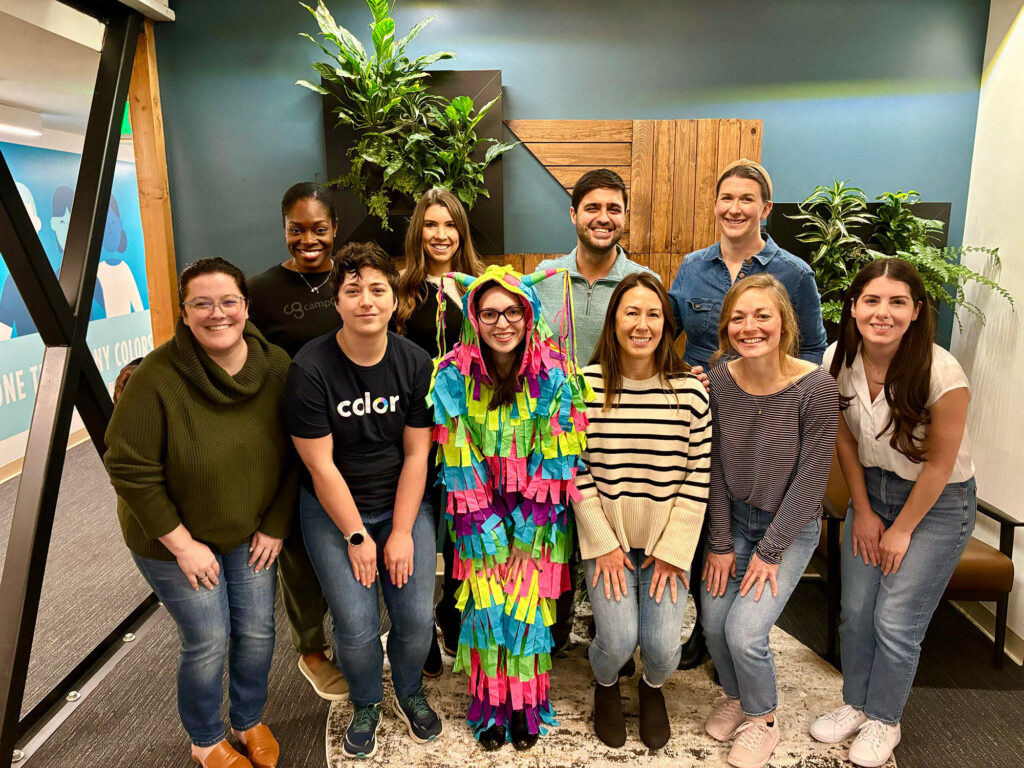News & Articles
Color at ASHG: a year of large-scale genomics research
Anjali Zimmer
This year a record number of people (7,005!) descended upon San Diego for the annual American Society of Human Genetics conference. Color, too, sent our largest-ever delegation to ASHG to nerd out on genetics, present our research, meet up with old colleagues, and talk about the exciting future in the space. It was a whirlwind trip filled with fantastic presentations, posters, and announcements.
Here, for those who missed some of our presentations, is a quick recap.
Open-Access Data and Low Coverage Whole Genomes
Alicia Zhou, Color’s head of research, made two major announcements:
- data.color.com — an open-access database of more than 2.8M variants in 30 hereditary cancer risk genes, along with clinical data from 50,000 research-consented individuals.
- Low coverage whole genome sequencing — a scalable, affordable solution that can help accelerate genome-wide applications.
With these two initiatives, Color is tackling several of today’s most pressing genomics issues: transparency in variant classification; open data sharing of case history with variants; cost-effective NGS data for variant discovery and GWAS; and better minority representation in polygenic risk scores. We’re proud of these efforts and hope they inspire others to make their databases more accessible and to prioritize addressing the genomic diversity gap.
Population Testing for Tier 1 Genomics Conditions
The CDC’s Office of Public Health Genomics (OPHG) has stated that testing of Hereditary Breast and Ovarian Cancer Syndrome, Lynch Syndrome, and Familial Hypercholesterolemia in the general population has significant potential for positive impact. Color has begun turning this potential into reality by partnering with organizations to offer genetic testing for these conditions as a voluntary employer-sponsored employee health benefit. Color scientist Cynthia Neben presented an analysis of this cohort at ASHG. Her study found a pathogenic rate (1:75) similar to population sequencing efforts like the Geisinger MyCode (1:78). Interestingly, 92.3% of people who carry a pathogenic Lynch syndrome mutation wouldn’t have met existing criteria for germline testing. This and other insights lend support to the position that population genetic testing for these conditions is a necessary component of preventative intervention. See the poster here.
Using low coverage sequencing for determining polygenic risk scores
GWAS and polygenic risk scores (PRS) have typically been performed with older genotyping array technology data. In order to report monogenic and polygenic disease risks, labs would have to support two types of equipment platforms, increasing the cost and complexity of testing. So, it was exciting to see data scientist Julian Homburger present his work using low-coverage genome sequencing as a data input for polygenic risk prediction. Working closely with Sekar Kathiresan, who was awarded the Curt Stern award at this year’s ASHG, Julian was able to demonstrate extremely high concordance of polygenic risk scores for breast cancer, cardiovascular disease, and atrial fibrillation, calculated from both traditional array data and low coverage whole genome sequencing data at a sequencing depth of 0.5X or more. Building on that foundation, he then showed the real-world association of low-coverage PRS with the self-reported health history of a population of over 2,500 individuals. See the poster here.
Disambiguating Structural Variants in PMS2
Highly homologous DNA regions present problems for short-read sequencing technologies. It’s challenging to place a read during alignment and even harder to obtain a confident variant call. Jeroen Van den Akker, a Color bioinformatics engineer, presented our approach to this issue. The strategy: using linked read technology to obtain full-gene, phased sequencing of the challenging 3’ end of the PMS2 gene, which is highly homologous to the PMS2CL pseudogene. See the poster here.
The first clinical implementation of DeepVariant with the Google AI team
Bioinformatics Engineer Lawrence Hon presented his work with the Google AI team on integrating DeepVariant into Color’s clinical bioinformatics pipeline. Google’s state-of-the-art, deep convolutional neural network differs from other commonly run variant callers in clinical labs in that it relies on imagine processing of the aligned .bam file. Lawrence demonstrated the added redundancy and sensitivity that DeepVariant adds to our existing suite of variant calling tools. See the poster here.
Novel GREM1 enhancer duplications
Raymond C. Chan and Jeroen Van den Akker reported their findings of six novel heterozygous duplication or triplication events of the enhancer region or the entirety of the Gremlin 1 gene (GREM1) in 14 individuals. Mutations in this region of GREM1 have been associated with hereditary mixed polyposis syndrome (HMPS), an autosomal dominant inherited cancer syndrome characterized by colorectal polyps of multiple or overlapping histological types. In this small cohort, we observed that carriers of duplications that span the whole GREM1 gene have less significant health history of colorectal cancer and polyps than do 24kb and 40kb duplications of the putative GREM1 enhancer. See the poster here.
Differential association of Lynch syndrome genes with colorectal and breast cancer
I presented an analysis of how the genes associated with Lynch Syndrome related to different cancer phenotypes. Historically, most Lynch Syndrome pathogenic variants have been found in MSH2 and MLH1, with a minority in MSH6, PMS2, and EPCAM. In our cohort, more people had a pathogenic variant in PMS2 (29.5%) or MSH6 (27.9%) than in MLH1 (17.2%) or MSH2 (25.5%). As expected, MLH1 and MSH2 pathogenic variants were more strongly associated than MSH6 and PMS2 with a history of colorectal cancer and a younger age of diagnosis. We didn’t see a differential association by gene for breast cancer. Our research highlighted the need for more population cohorts to help determine the phenotypic spectrum associated with these genes. See the poster here.
Direct Digital engagement for communicating updated test results
Color’s Laboratory Director, Scott Topper, examined the effectiveness of digital communication when informing patients of updated genetic results. Patients were notified of an updated report when a variant classification was updated based on new scientific knowledge or their health history was changed in a way that would change clinical information presented in a report. Scott and team counted the time from sending the the email informing the patient about their updated report until the person viewed their updated report. We observed that digital communication is an effective way to reach most of the population in a timely manner. To our knowledge, this is first study examining the practicality and effectiveness of digitally contacting patients about updated genetic reports. See the poster here.
To learn more about our current and upcoming studies and find out how to add Color genetic testing to your research study, you can find us at color.com/research. See you all next year!



